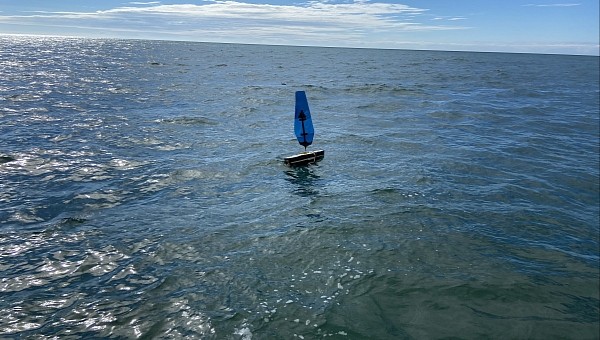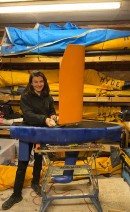Only 1.25 meters long (4.10 feet) and weighing 50 kg (110 lb) this sailboat looks rather humble, but it hides the soul of a pioneer. Designed and built by two 23-year-old entrepreneurs based in Wales, UK, the Oshen autonomous boat hopes to someday replace all the plastic contraptions that are currently polluting the oceans in order to get weather data.
Did you know that there’s a transatlantic race for autonomous boats? It’s called The Microtransat Challenge. A small (and young) team in Wales is hoping to win this race with its robot sailboat, which would make it the first fully-autonomous sailing vessel under 2.4 meters (7.8 feet) to successfully complete this crossing.
Anahita Laverack and Ciaran Dowds are the founders of Oshen, the startup that’s building this vessel as a sustainable solution for gathering ocean data in support of weather forecast technology. The watercraft would run entirely on wind and solar power, and would be capable of sailing back after collecting the required data, with zero impact on the maritime environment.
Equipped with rigid wind sails that are one meter tall (3.28 feet) that would harness the power of wind for navigation, plus solar panels for powering the onboard electric systems, the Oshen sailboat is designed for emission-free, autonomous operations.
It’s rugged enough to handle challenging weather conditions, while making its way to areas that are harder to reach for larger platforms, and it’s advanced enough to send data in real-time using satellite communications.
The Oshen team hopes that one day this robotic sailboat could replace the thousands of plastic buoys that are being used for the same purpose, but end up drifting in the ocean. At the same time, the Oshen vessel would be much more affordable to operate than the large autonomous surface vehicles (ASVs) available today.
Oshen has already secured significant funding through various competitions, and plans to demonstrate this technology in the future Microtransat Challenge. In the meantime, the team is focusing on testing the autopilot software for acoustic sensing, within the Innovate UK project.
The idea itself isn’t a new one. Over in the U.S., a watercraft called Saildrone is using similar principles for various types of operations, from ocean data collecting to maritime surveillance for the Navy.
The Saildrone Explorer uses only wind power and solar power while navigating autonomously, but it’s much bigger than the Oshen sailboat (23 feet/7 meters). The Saildrone Voyager and Surveyor are even larger, and are equipped with a diesel-electric system in addition to the wind propulsion.
The tiny Oshen is much more powerful than it looks, and perhaps it will be able to prove it when crossing the Atlantic. That could be the starting point for a future where thousands of these autonomous sailboats take over the ocean, improving weather forecasting with no environmental harm.
Anahita Laverack and Ciaran Dowds are the founders of Oshen, the startup that’s building this vessel as a sustainable solution for gathering ocean data in support of weather forecast technology. The watercraft would run entirely on wind and solar power, and would be capable of sailing back after collecting the required data, with zero impact on the maritime environment.
Equipped with rigid wind sails that are one meter tall (3.28 feet) that would harness the power of wind for navigation, plus solar panels for powering the onboard electric systems, the Oshen sailboat is designed for emission-free, autonomous operations.
It’s rugged enough to handle challenging weather conditions, while making its way to areas that are harder to reach for larger platforms, and it’s advanced enough to send data in real-time using satellite communications.
The Oshen team hopes that one day this robotic sailboat could replace the thousands of plastic buoys that are being used for the same purpose, but end up drifting in the ocean. At the same time, the Oshen vessel would be much more affordable to operate than the large autonomous surface vehicles (ASVs) available today.
Oshen has already secured significant funding through various competitions, and plans to demonstrate this technology in the future Microtransat Challenge. In the meantime, the team is focusing on testing the autopilot software for acoustic sensing, within the Innovate UK project.
The idea itself isn’t a new one. Over in the U.S., a watercraft called Saildrone is using similar principles for various types of operations, from ocean data collecting to maritime surveillance for the Navy.
The Saildrone Explorer uses only wind power and solar power while navigating autonomously, but it’s much bigger than the Oshen sailboat (23 feet/7 meters). The Saildrone Voyager and Surveyor are even larger, and are equipped with a diesel-electric system in addition to the wind propulsion.
The tiny Oshen is much more powerful than it looks, and perhaps it will be able to prove it when crossing the Atlantic. That could be the starting point for a future where thousands of these autonomous sailboats take over the ocean, improving weather forecasting with no environmental harm.







